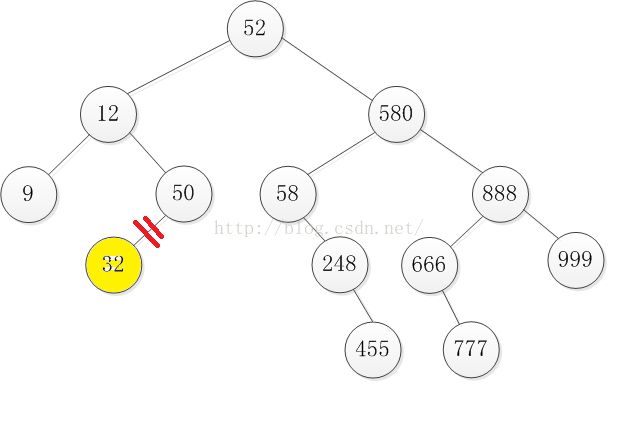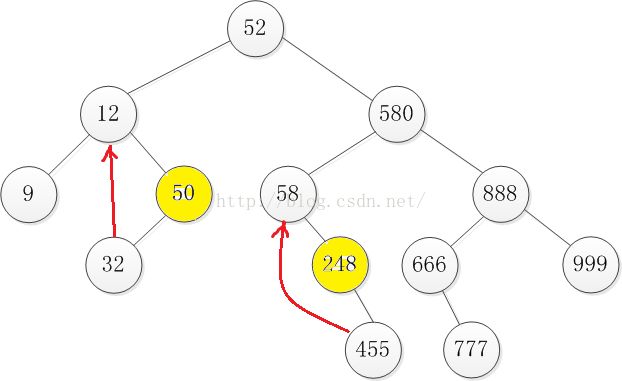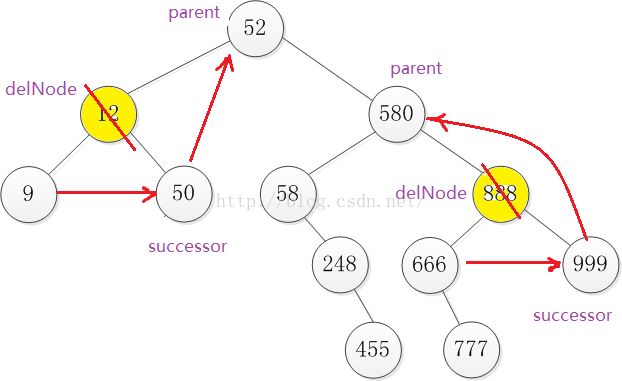二叉树之Java实现二叉树基本操作
参考自《Java数据结构与算法》
- 定义一个节点类,使节点与二叉树操作分离
class Node {
int value;
Node leftChild;
Node rightChild;
Node(int value) {
this.value = value;
}
public void display() {
System.out.print(this.value + "\t");
}
@Override
public String toString() {
// TODO Auto-generated method stub
return String.valueOf(value);
}
}- 需要实现的二叉树操作
class BinaryTree {
private Node root = null;
BinaryTree(int value) {
root = new Node(value);
root.leftChild = null;
root.rightChild = null;
}
public Node findKey(int value) {} //查找
public String insert(int value) {} //插入
public void inOrderTraverse() {} //中序遍历递归操作
public void inOrderByStack() {} //中序遍历非递归操作
public void preOrderTraverse() {} //前序遍历
public void preOrderByStack() {} //前序遍历非递归操作
public void postOrderTraverse() {} //后序遍历
public void postOrderByStack() {} //后序遍历非递归操作
public int getMinValue() {} //得到最小(大)值
public boolean delete(int value) {} //删除
}- 查找数据:
public Node findKey(int value) {
Node current = root;
while (true) {
if (value == current.value) {
return current;
} else if (value < current.value) {
current = current.leftChild;
} else if (value > current.value) {
current = current.rightChild;
}
if (current == null) {
return null;
}
}
}- 插入数据:与查找数据类似,不同点在于当节点为空时,不是返回而是插入
public String insert(int value) {
String error = null;
Node node = new Node(value);
if (root == null) {
root = node;
root.leftChild = null;
root.rightChild = null;
} else {
Node current = root;
Node parent = null;
while (true) {
if (value < current.value) {
parent = current;
current = current.leftChild;
if (current == null) {
parent.leftChild = node;
break;
}
} else if (value > current.value) {
parent = current;
current = current.rightChild;
if (current == null) {
parent.rightChild = node;
break;
}
} else {
error = "having same value in binary tree";
}
} // end of while
}
return error;
}- 遍历数据:
1)中序遍历:最常用的一种遍历方法
/**
* //中序遍历(递归):
* 1、调用自身来遍历节点的左子树
* 2、访问这个节点
* 3、调用自身来遍历节点的右子树
*/
public void inOrderTraverse() {
System.out.print("中序遍历:");
inOrderTraverse(root);
System.out.println();
}
private void inOrderTraverse(Node node) {
if (node == null)
return ;
inOrderTraverse(node.leftChild);
node.display();
inOrderTraverse(node.rightChild);
}
/**
* 中序非递归遍历:
* 1)对于任意节点current,若该节点不为空则将该节点压栈,并将左子树节点置为current,重复此操作,直到current为空。
* 2)若左子树为空,栈顶节点出栈,访问节点后将该节点的右子树置为current
* 3) 重复1、2步操作,直到current为空且栈内节点为空。
*/
public void inOrderByStack() {
System.out.print("中序非递归遍历:");
Stack stack = new Stack();
Node current = root;
while (current != null || !stack.isEmpty()) {
while (current != null) {
stack.push(current);
current = current.leftChild;
}
if (!stack.isEmpty()) {
current = stack.pop();
current.display();
current = current.rightChild;
}
}
System.out.println();
} 2)前序遍历:
/**
* //前序遍历(递归):
* 1、访问这个节点
* 2、调用自身来遍历节点的左子树
* 3、调用自身来遍历节点的右子树
*/
public void preOrderTraverse() {
System.out.print("前序遍历:");
preOrderTraverse(root);
System.out.println();
}
private void preOrderTraverse(Node node) {
if (node == null)
return ;
node.display();
preOrderTraverse(node.leftChild);
preOrderTraverse(node.rightChild);
}
/**
* 前序非递归遍历:
* 1)对于任意节点current,若该节点不为空则访问该节点后再将节点压栈,并将左子树节点置为current,重复此操作,直到current为空。
* 2)若左子树为空,栈顶节点出栈,将该节点的右子树置为current
* 3) 重复1、2步操作,直到current为空且栈内节点为空。
*/
public void preOrderByStack() {
System.out.print("前序非递归遍历:");
Stack stack = new Stack();
Node current = root;
while (current != null || !stack.isEmpty()) {
while (current != null) {
stack.push(current);
current.display();
current = current.leftChild;
}
if (!stack.isEmpty()) {
current = stack.pop();
current = current.rightChild;
}
}
System.out.println();
} 3)后序遍历:
/**
* //后序遍历(递归):
* 1、调用自身来遍历节点的左子树
* 2、调用自身来遍历节点的右子树
* 3、访问这个节点
*/
public void postOrderTraverse() {
System.out.print("后序遍历:");
postOrderTraverse(root);
System.out.println();
}
private void postOrderTraverse(Node node) {
if (node == null)
return ;
postOrderTraverse(node.leftChild);
postOrderTraverse(node.rightChild);
node.display();
}/**
* 后序非递归遍历:
* 1)对于任意节点current,若该节点不为空则访问该节点后再将节点压栈,并将左子树节点置为current,重复此操作,直到current为空。
* 2)若左子树为空,取栈顶节点的右子树,如果右子树为空或右子树刚访问过,则访问该节点,并将preNode置为该节点
* 3) 重复1、2步操作,直到current为空且栈内节点为空。
*/
public void postOrderByStack() {
System.out.print("后序非递归遍历:");
Stack stack = new Stack();
Node current = root;
Node preNode = null;
while (current != null || !stack.isEmpty()) {
while (current != null) {
stack.push(current);
current = current.leftChild;
}
if (!stack.isEmpty()) {
current = stack.peek().rightChild;
if (current == null || current == preNode) {
current = stack.pop();
current.display();
preNode = current;
current = null;
}
}
}
System.out.println();
} - 得到最小(大)值:依次向左(右)直到空为之
public int getMinValue() {
Node current = root;
while (true) {
if (current.leftChild == null)
return current.value;
current = current.leftChild;
}
}- 删除:删除操作很复杂,删除节点大致分为三种情况:
2)删除节点只有一个子节点:只有一个左子节点和只有一个右子节点
3)删除节点有两个子节点:这种情况比较复杂,需要寻找后继节点,即比要删除的节点的关键值次高的节点是它的后继节点。
说得简单一些,后继节点就是比要删除的节点的关键值要大的节点集合中的最小值。
得到后继节点的代码如下:
/**
*
* 得到后继节点,即删除节点的左后代
*/
private Node getSuccessor(Node delNode) {
Node successor = delNode;
Node successorParent = null;
Node current = delNode.rightChild;
while (current != null) {
successorParent = successor;
successor = current;
current = current.leftChild;
}
//如果后继节点不是删除节点的右子节点时,
if (successor != delNode.rightChild) {
//要将后继节点的右子节点指向后继结点父节点的左子节点,
successorParent.leftChild = successor.rightChild;
//并将删除节点的右子节点指向后继结点的右子节点
successor.rightChild = delNode.rightChild;
}
//任何情况下,都需要将删除节点的左子节点指向后继节点的左子节点
successor.leftChild = delNode.leftChild;
return successor;
}
//删除的节点为父节点的左子节点时:
parent.leftChild = successor;
successor.leftChild = delNode.leftChild;
//删除的节点为父节点的右子节点时:
parent.rightChild = successor;
successor.leftChild = delNode.leftChildb)如果后继节点为要删除节点的右子节点的左后代:
//删除的节点为父节点的左子节点时:
successorParent.leftChild = successor.rightChild;
successor.rightChild = delNode.rightChild;
parent.leftChild = successor;
successor.leftChild = delNode.leftChild;
//删除的节点为父节点的右子节点时:
successorParent.leftChild = successor.rightChild;
successor.rightChild = delNode.rightChild;
parent.rightChild = successor;
successor.leftChild = delNode.leftChild;综合以上各种情况,删除代码如下:
public boolean delete(int value) {
Node current = root; //需要删除的节点
Node parent = null; //需要删除的节点的父节点
boolean isLeftChild = true; //需要删除的节点是否父节点的左子树
while (true) {
if (value == current.value) {
break;
} else if (value < current.value) {
isLeftChild = true;
parent = current;
current = current.leftChild;
} else {
isLeftChild = false;
parent = current;
current = current.rightChild;
}
//找不到需要删除的节点,直接返回
if (current == null)
return false;
}
//分情况考虑
//1、需要删除的节点为叶子节点
if (current.leftChild == null && current.rightChild == null) {
//如果该叶节点为根节点,将根节点置为null
if (current == root) {
root = null;
} else {
//如果该叶节点是父节点的左子节点,将父节点的左子节点置为null
if (isLeftChild) {
parent.leftChild = null;
} else { //如果该叶节点是父节点的右子节点,将父节点的右子节点置为null
parent.rightChild = null;
}
}
}
//2、需要删除的节点有一个子节点,且该子节点为左子节点
else if (current.rightChild == null) {
//如果该节点为根节点,将根节点的左子节点变为根节点
if (current == root) {
root = current.leftChild;
} else {
//如果该节点是父节点的左子节点,将该节点的左子节点变为父节点的左子节点
if (isLeftChild) {
parent.leftChild = current.leftChild;
} else { //如果该节点是父节点的右子节点,将该节点的左子节点变为父节点的右子节点
parent.rightChild = current.leftChild;
}
}
}
//2、需要删除的节点有一个子节点,且该子节点为右子节点
else if (current.leftChild == null) {
//如果该节点为根节点,将根节点的右子节点变为根节点
if (current == root) {
root = current.rightChild;
} else {
//如果该节点是父节点的左子节点,将该节点的右子节点变为父节点的左子节点
if (isLeftChild) {
parent.leftChild = current.rightChild;
} else { //如果该节点是父节点的右子节点,将该节点的右子节点变为父节点的右子节点
parent.rightChild = current.rightChild;
}
}
}
//3、需要删除的节点有两个子节点,需要寻找该节点的后续节点替代删除节点
else {
Node successor = getSuccessor(current);
//如果该节点为根节点,将后继节点变为根节点,并将根节点的左子节点变为后继节点的左子节点
if (current == root) {
root = successor;
} else {
//如果该节点是父节点的左子节点,将该节点的后继节点变为父节点的左子节点
if (isLeftChild) {
parent.leftChild = successor;
} else { //如果该节点是父节点的右子节点,将该节点的后继节点变为父节点的右子节点
parent.rightChild = successor;
}
}
}
current = null;
return true;
}- 测试代码
public class BinaryTreeDemo {
public static void main(String[] args) {
BinaryTree bt = new BinaryTree(52);
bt.insert(580);
bt.insert(12);
bt.insert(50);
bt.insert(58);
bt.insert(9);
bt.insert(888);
bt.insert(248);
bt.insert(32);
bt.insert(666);
bt.insert(455);
bt.insert(777);
bt.insert(999);
bt.inOrderTraverse();
bt.preOrderTraverse();
bt.postOrderTraverse();
System.out.println(bt.findKey(32));
System.out.println(bt.findKey(81));
System.out.println("最小值:" + bt.getMinValue());
// bt.delete(32); //删除叶子节点
// bt.delete(50); //删除只有一个左子节点的节点
// bt.delete(248); //删除只有一个右子节点的节点
// bt.delete(248); //删除只有一个右子节点的节点
// bt.delete(580); //删除有两个子节点的节点,且后继节点为删除节点的右子节点的左后代
// bt.delete(888); //删除有两个子节点的节点,且后继节点为删除节点的右子节点
bt.delete(52); //删除有两个子节点的节点,且删除节点为根节点
bt.inOrderTraverse();
}
}中序遍历:91232 50 52 58248455580 666777 888999
中序非递归遍历:9 12 32 50 5258248 455580 666777 888999
前序遍历:52 12 9 50 3258058 248 455 888 666 777 999
前序非递归遍历:52 12 9 50 3258058 248 455 888 666 777 999
后序遍历:9 32 50 12 45524858 777 666 999 888 580 52
后序非递归遍历:9 32 50 12 45524858 777 666 999 888 580 52
32
null
最小值:9
中序遍历:9 12 32 50 58248455580 666777 888999



